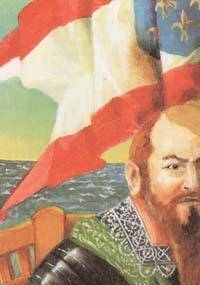|
The Flight of the Earls

In September 1607 a
French ship sailed from the northern harbour of Rathmullan in Lough Swilly. On
board were Hugh O'Neill, Earl of Tyrone, and Rory O'Donnell, Earl of
Tyrconnell, together with more than ninety of their family and followers. Their
ship was bound for Spain, but fierce storms forced them to disembark in France
in early October. Thereafter they made their way to Rome, where they remained
in voluntary exile, and where O'Neill died in 1616.
For centuries the native Irish had struggled to preserve the Gaelic
way of life, with its distinct laws and customs. Through inter-marriage many of
the Norman conquerors had become "more Irish than the Irish", until
the King of England's rule had been confined to a small area around Dublin
known as the Pale. During the sixteenth century, successive Tudor monarchs
tried to extend their authority, but there was always strong resistance from
the northern province of Ulster. Religion became a factor in the struggle. Soon
after the Protestant Queen Elizabeth came to the English throne in 1558, an
Irish parliament passed an Act of Supremacy confirming her as head of the Irish
Church, and requiring office-holders in church and state to swear allegiance toher. The Gaels and
their "Old English" allies remained staunchly loyal to the Roman
Catholic Church.
As a boy, Hugh O'Neill had been taken into the care of Elizabeth's
viceroy, Sir Henry Sidney, and raised as an English nobleman. After returning
to his native County Tyrone, he had shown his loyalty by helping to suppress
the Desmond rebellion in Munster. In 1587 he was recognised as Earl of Tyrone,
and was granted extensive territory under the Crown. A year later, however, he ignored a government order to execute
survivors of the Spanish armada who landed in Ireland, and in Dublin there were
increasing doubts about O'Neill's loyalty. The doubts were justified. O'Neill
was allowed to keep 600 men in arms at the Queen's expense, and by regularly
changing them he was able to train a substantial army. Lead to roof his new
castle at Dungannon was turned into bullets.
|
Elsewhere in Ireland, English government was tightening its grip. In
Connacht, the Gaelic lords had submitted to the Crown. In Munster, following
the defeat of the second Desmond rebellion in 1583, English settlers had
acquired confiscated land. In Ulster, though, there were
no English settlers or garrisons west of Lough Neagh. With its mountains, lakes
and forests, the region was eminently defensible, and O'Neill found a vigorous
ally in Red Hugh 0 'Donnell ofTyrconnell, who had escaped from imprisonment in
Dublin. In 1593, O'Neill took the now illegal Gaelic title of "The
O'Neill" and prepared to lead the Ulster chiefs in defence of territory
and religion.
O'Neill was a skilful commander, and his troops exploited the
difficult terrain to harry the English columns. In 1595, he won a handsome
victory at Clontibret, near Monaghan, over an army commanded by his
brother-in-law, Sir Henry Bagenal. Bagenal was to lose his life during the
Battle of the Yellow Ford, on the River Blackwater, in 1598. This was 0
'Neill's greatest triumph. In 1601 he made the mistake of marching to the
southern port of Kinsale to join an invading Spanish army, and the Irish were
routed in unfamiliar country.

0'Donnell fled to Spain, but O'Neill returned to Tyrone. In 1603 he
submitted to the Queen's representative, Lord Mountjoy, as 0'Donnell's brother
Rory had earlier done. However, despite a generous settlement in which he
retained his earldom, O'Neill found English rule unacceptable. When the flight
of the earls denuded Ulster of its Gaelic aristocracy in 1607, the government
took the opportunity to confiscate six of the nine Ulster counties. The
subsequent plantation of Ulster, introducing Protestant settlers from England
and Scotland, laid the foundation of today's divided island.
|